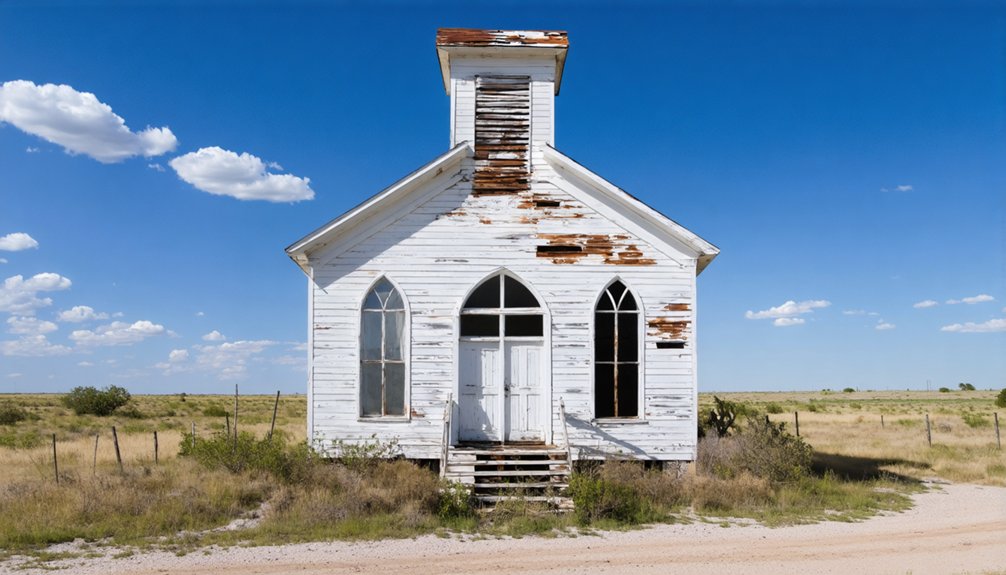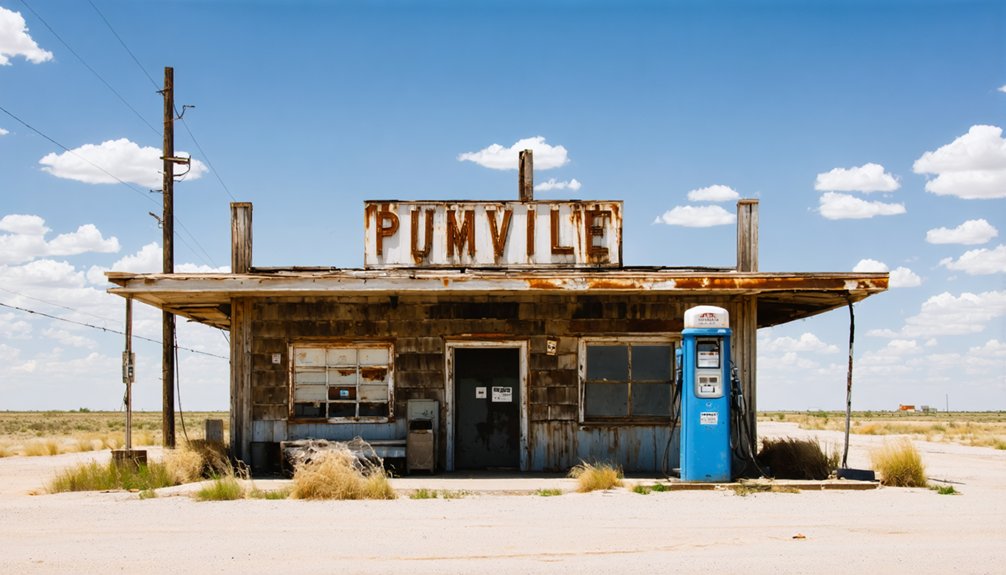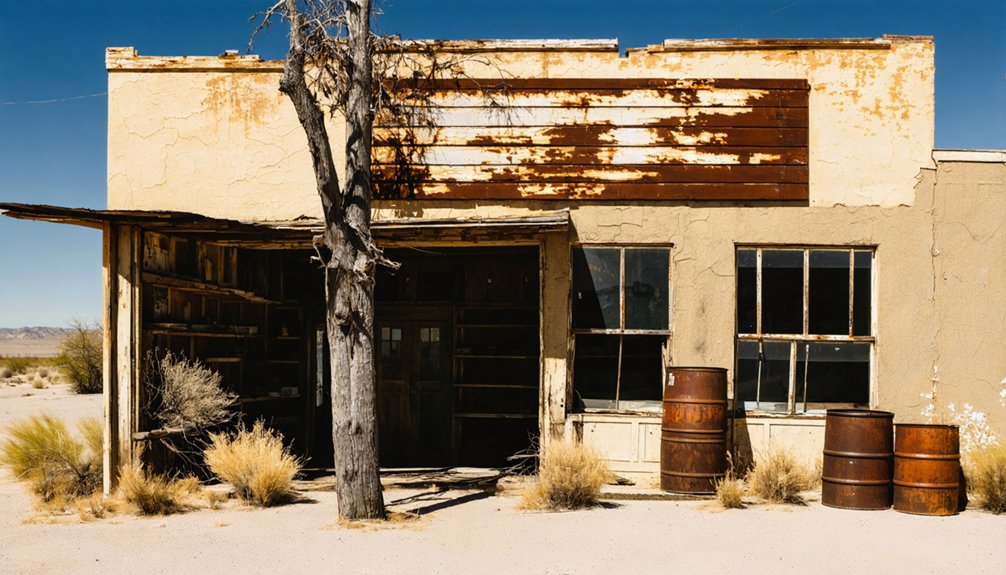You’ll find Pumpville’s ghostly remains along an abandoned stretch of the Southern Pacific Railroad in Val Verde County, Texas. This former railway water stop, established in 1882, was essential for steam locomotives during transcontinental journeys. The town flourished with its 600-foot-deep wells, depot, and livestock shipping operations until diesel engines made it obsolete in the 1950s. Today, you can explore the ruins, including the historic Baptist church – a silent witness to Pumpville’s heyday.
Key Takeaways
- Pumpville, Texas was established in 1882 as a crucial railroad water stop before becoming abandoned in 1955 due to railroad modernization.
- The town’s population declined dramatically after diesel locomotives eliminated the need for water stops, falling to just 21 residents by 1968.
- Original structures include remnants of the railroad depot, telegraph office, and distinctive water filtration system with gooseneck water columns.
- The Pumpville Baptist Church remains as one of the few intact structures, serving as a landmark in this Trans-Pecos ghost town.
- Located in Val Verde County, Pumpville is accessible via Farm to Market Road 1865, approximately 2 miles north of U.S. Highway 90.
A Railway Town Born From Steam
When the Southern Pacific Railroad expanded through Val Verde County in 1882, it established a water stop initially named Samuels that would later become Pumpville.
Railroad innovation transformed this remote Texas location into a crucial hub when wells were drilled in 1887, reaching 600 feet underground to supply essential water for steam technology.
You’ll find the town’s development was purposefully centered around the railroad’s water needs. A specialized pump house was constructed to filter the hard water before it could be used in the locomotives, featuring a gooseneck water column for filling train tenders.
The railroad company built all the necessary infrastructure: a depot, water tank, tool shed, salt shed, telegraph office, and housing for workers, creating a self-sufficient community driven by steam-powered transportation. The town grew into an important livestock shipping point under the management of Ernest P. Bradford. Local residents primarily earned their living through railway employment and ranch work.
Location and Geographic Features
Located in Val Verde County’s semiarid ranch country, Pumpville sits approximately 2 miles north of U.S. Highway 90, between Langtry and Dryden.
Tucked away in Val Verde County’s rugged ranchlands, the ghost town of Pumpville rests quietly north of Highway 90.
You’ll find this West Texas ghost town at coordinates 29°56’35″N 101°44’6″W, accessible via Farm to Market Road 1865.
The town’s geographic significance stems from its position in the Trans-Pecos region, where an essential well was drilled 600 feet deep to service steam locomotives.
The desert ecosystem features typical vegetation of the region, supporting wildlife like coyotes, bobcats, and various bird species. The historic Pumpville Baptist Church remains one of the few standing structures in this desolate landscape.
The closest notable settlement is Langtry, about 13.6 miles southeast, making Pumpville a truly remote outpost.
A small hamlet called Casa de Peidras lies 12 miles to the southwest of Pumpville.
You’ll experience warm winters and hot summers in this harsh terrain, characterized by sedimentary and metamorphic rocks.
The Story Behind the Name
The name “Pumpville” emerged from the town’s primary purpose as an essential water station for steam locomotives along the Southern Pacific Railroad in 1882.
Originally called Samuels, the site’s name origin directly reflected its critical function of providing filtered water from deep wells for steam engines.
The historical significance of Pumpville‘s name is preserved through these key elements:
- A distinctive gooseneck arm on water columns serviced passing locomotives
- Water infrastructure included 600-foot-deep wells with filtration systems
- The pump house was the economic backbone of the community
- Supporting facilities included a depot and telegraph office
- The name documented a specific era of steam-powered railroad technology
Today, though Pumpville stands as a ghost town, its name remains a symbol of the technological demands of America’s railroad age.
Located in Val Verde County, the small community persisted through decades of railway service.
The town maintained a steady population of 21 from 1968 to 2000, reflecting its enduring but minimal presence along the railway route.
Life in Early Pumpville
Life in early Pumpville centered around its essential role as a railroad water station, with a small but industrious community emerging from the infrastructure built to support steam locomotives.
You’d find a self-sufficient town with a depot, salt shed, housing for railroad workers, and a telegraph office. The addition of a post office in 1899 and a general store strengthened the community’s foundation. A freshwater well provided the vital resource needed to operate the pumping station in the early 1880s.
Many treasure hunters today use historical maps to locate these old railroad structures and discover artifacts from the town’s past. Livestock shipping became a vital economic driver, with ranchers using the pens and loading chutes to transport their sheep, goats, and cattle.
Community gatherings often took place at the Baptist church, established in the 1940s, where Sunday services brought together railroad workers, ranchers, and their families.
Despite the harsh semiarid environment and basic living conditions, residents maintained strong social bonds through church events and shared work responsibilities.
Railroad Operations and Water Stop Legacy
You’ll find Pumpville’s most vital railroad infrastructure centered around its 1882 water stop, where steam locomotives routinely replenished their boilers during long hauls through West Texas.
The strategic location of the pumphouse and depot, situated 2.5 miles north of the townsite, made it an essential supply point for the Galveston, Harrisburg & San Antonio Railway’s steam engines.
The water tower operations sustained both the railway’s needs and supported the area’s burgeoning livestock trade, as ranchers capitalized on the stop’s dual function as a cattle shipping point.
Steam Engine Supply Station
Southern Pacific Railroad established Pumpville’s steam engine supply station in 1882 as a critical water stop along their West Texas line.
You’ll find that steam engine technology required frequent water replenishment, making the station’s 600-foot-deep wells essential for transcontinental runs. The station’s water filtration systems processed hard well water to protect locomotive boilers from damage.
The supply station’s core infrastructure included:
- Pump house with filtration equipment
- Gooseneck water column for rapid tender filling
- Telegraph office for coordinating train movements
- Railroad maintenance facilities and crew housing
- Livestock pens and loading chutes for regional shipping
The station thrived until the 1950s when diesel locomotives eliminated the need for water stops, leading to Pumpville’s eventual transformation from a bustling railroad hub to a ranching community.
Water Tower Operations
Building upon the station’s core infrastructure, Pumpville’s water tower operations formed the heart of its railroad identity from 1882 onwards.
You’ll find that the town’s water supply system was meticulously engineered, with wells drilled at Samuels to guarantee steam locomotives could refuel along the Galveston, Harrisburg & San Antonio Railway route.
The railroad faced significant logistical challenges in maintaining consistent water quality and availability.
You’d have noticed how seasonal variations and local geological conditions impacted the reliability of water delivery to passing trains.
The all-steel riveted design of the water tower represented cutting-edge engineering for its time period, ensuring durability and reliability.
The system required constant maintenance to prevent engine damage and maintain smooth operations.
When diesel engines eventually replaced steam locomotives, Pumpville’s essential role as a water stop diminished, though its water tower remained a symbol of the era of steam-powered rail transport.
The facilities were ultimately abandoned in 1955 as the railroad industry modernized its operations.
Strategic Railroad Location
Three key factors made Pumpville’s railroad location strategically important in 1882: its position along the Galveston, Harrisburg & San Antonio Railway, its role as a significant water stop for steam locomotives, and its function as a livestock shipping hub.
Railroad logistics demanded precisely placed water stops for steam locomotion to function effectively.
You’ll find Pumpville’s infrastructure was purposefully designed with:
- A dedicated pumphouse for water operations
- A fully equipped railroad depot
- Necessary crew facilities
- Maintenance buildings
- Strategic positioning 2.5 miles from the water source
The site’s calculated placement proved essential for both rail operations and regional commerce, enabling ranchers to move their livestock to market while providing vital support for the era’s steam-powered transportation network.
This strategic positioning helped establish Pumpville as a cornerstone of West Texas rail operations.
Baptist Church: A Surviving Landmark

In the heart of Val Verde County, the Pumpville Baptist Church stands as a tribute to enduring faith and community spirit since its establishment in 1927.
While the surrounding ghost town has succumbed to time, this historic church remains operational, reflecting remarkable community resilience through decades of regional decline.
Despite the ghost town’s fade into history, this church stands strong – a beacon of faith weathering time’s endless march.
You’ll find the church on Pumpville Drive, where a dedicated congregation of 15-20 members gathers every Sunday for services at 10:00 AM, followed by traditional worship at 11:00 AM.
Under Reverend Paul Ray‘s leadership, the church maintains its original character with rustic pews and no modern amenities.
It’s more than just a building – it’s a living piece of church history, supporting 37 missionaries and hosting annual revival meetings that draw people from across the region.
The Post-War Decline
Following World War II, you’ll find that Pumpville’s fate was sealed by the Southern Pacific Railroad’s switch from steam to diesel locomotives, which eliminated the need for water stops that had been the town’s primary purpose.
The railroad depot’s closure in 1952 and the complete abandonment of water services by 1955 marked the beginning of an irreversible decline.
The population dropped sharply, falling to just 21 residents between 1968 and 2000, transforming this once-vital railroad stop into a ghost town.
Railroad Modernization Impact
When diesel locomotives replaced steam engines in the post-war era, Pumpville’s crucial role as a water stop became obsolete.
The railroad infrastructure changes brought devastating economic repercussions to this once-bustling Texas town. You’ll find that modernization stripped away the town’s crucial facilities, from the pumphouse to the depot, eliminating jobs and dismantling the local economy.
The impact of these changes manifested in several critical ways:
- Loss of railroad-related employment
- Closure of the general store and post office
- Reduced regional commerce and trade
- Consolidation of operations to larger hubs
- Deterioration of auxiliary services
As the railroads automated their operations and increased train speeds, Pumpville lost its strategic importance.
The town’s transformation from a rail service hub to a simple ranching community marked the end of its railroad-dependent prosperity.
Population Exodus Timeline
The post-war decline of Pumpville unfolded through distinct phases between the late 1940s and 1970, transforming this once-vibrant railroad town into a virtual ghost town.
You’ll find the population trends followed a clear downward trajectory, triggered by Southern Pacific Railroad’s withdrawal of employees. The 1952 depot closure and 1955 water service abandonment accelerated the exodus.
Community dynamics shifted dramatically when the school closed in 1957, forcing families to send children 15 miles away to Langtry. By 1965, you’d have seen just one family remaining, with the Pumpville Mercantile’s closure marking the end of local commerce.
The final blow came in 1970 when the Baptist church and post office closed, though a brief spiritual revival occurred in 1985 when church services resumed for scattered ranchers.
Exploring Today’s Ghost Town

Located along Ranch to Market Road 1865 in Val Verde County, today’s Pumpville stands as a stark reminder of Texas’s railroad history.
You’ll find excellent ghost town photography opportunities among the weathered remnants of abandoned architecture, including the historic water pump house and defunct railroad structures.
While exploring the site, you’ll discover:
- The still-operational Pumpville Baptist Church, the region’s most isolated house of worship
- Former railroad infrastructure including the depot and telegraph office ruins
- Abandoned livestock pens and loading chutes from ranching days
- Historic worker housing in various states of decay
- The original water filtration system that served steam locomotives
The town’s remote location and harsh environment have preserved its authentic ghost town character, making it a compelling destination for those seeking to experience a genuine piece of Texas’s railroad past.
Historical Recognition and Documentation
Pumpville’s historical significance extends far beyond its physical remains, with extensive documentation cementing its place in Texas history.
You’ll find the town’s legacy preserved in official records, from its 1882 founding as a Southern Pacific Railroad water stop to its 71-year run as a federally recognized post office. The town’s role in rail transport is well-documented through railroad archives detailing its infrastructure, including the pump house and telegraph office that once supported steam engine operations.
State histories highlight Pumpville’s connection to notable train robberies in the late 1800s and its importance as a livestock shipping point.
Today, you can trace the town’s evolution through postal records, archived interviews, and Texas ghost town directories, while the still-active Baptist church stands as a living representation of the community’s enduring spirit.
Frequently Asked Questions
Are There Any Reported Ghost Sightings or Paranormal Activity in Pumpville?
You won’t find documented ghostly encounters or paranormal investigations in this location, despite its train robbery history. While the abandoned setting creates an eerie atmosphere, there’s no verified supernatural activity.
What Happened to the Original Residents and Their Descendants?
Most original inhabitants moved away after the railroad’s decline, seeking better opportunities elsewhere. You’ll find their descendants scattered across Val Verde County and Texas, with some maintaining local ranching ties.
Can Visitors Legally Access and Explore the Remaining Buildings?
You’ll find legal access at the historical marker and public roads, but don’t enter the active Baptist church without permission. You can explore visible foundations and ruins while avoiding posted private property.
Were There Any Notable Crimes or Mysteries Associated With Pumpville?
You won’t find unsolved disappearances or historical legends here. The only notable crimes were two railroad robberies – one by Black Jack Ketchum in 1897 and another by three bandits in 1889.
What Natural Disasters or Severe Weather Events Has Pumpville Experienced?
Like a parched throat in the desert, you’d find Pumpville endured chronic drought impact through the years. While flash flood damage threatened the region, no major disasters are specifically recorded hitting the town.
References
- https://en.wikipedia.org/wiki/Pumpville
- https://www.dpreview.com/galleries/5315854781/photos/1612672/ghost-town-pumpville-texas
- https://pastmaps.com/explore/us/texas/val-verde-county/pumpville/metal-detecting
- https://atlas.thc.texas.gov/Details/5507013411/print
- https://en.wikipedia.org/wiki/List_of_ghost_towns_in_Texas
- https://www.ghosttowns.com/states/tx/pumpville.html
- https://www.tshaonline.org/handbook/entries/pumpville-tx
- https://www.texasescapes.com/TOWNS/Texas_ghost_towns/Pumpville_Texas/Pumpville_Texas.htm
- https://www.legendsofamerica.com/pumpville-texas/
- https://www.hmdb.org/m.asp?m=111475



